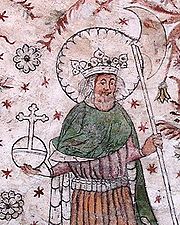Pilgrimage to Nidaros Cathedral
Similar to the Way of St. James , the Nidaros Ways are a network of several pilgrimage routes that all end at the Nidaros Cathedral . The Norwegian pilgrimage route (Pilegrimsleden) from Oslo to Trondheim (Nidaros) , also St. Olavsweg (Olavsvegen), was reopened in 1997. In German the name is also written St. Olaf . The pilgrimage route is derived from King Olav II Haraldsson . Holy King Olav was buried in Nidaros in 1030 after he fell in a battle near Stiklestad while marching on the Swedish-Norwegian St. Olavsleden . The Nidaros Cathedral was built over his grave.
On the history of the pilgrimage destination
According to his attributed miracles , Trondheim became a Christian place of pilgrimage for four centuries. The history of saints and the pilgrimage connected with it was certainly also a link in the Nordic monarchy. It is said that immediately after Olav's death and canonization one year later on August 3, 1031, a wooden chapel was built over his grave. Approx. In 1070 the Norwegian King Olav Kyrre laid the foundation stone for today's cathedral. He had the chapel replaced by a stone church (1090). Archbishop Øystein Erlendsson (1161–1188) is handed down as the first architect of the constantly expanding cathedral in the (now neo) Gothic style and as the builder . The high altar with the king's shrine used to stand above the former royal tomb. On the church building, in addition to the main facade with a large rose window and two towers, the mighty, central crossing tower with a high copper helmet is impressive. Trondheim was the seat of the Norwegian Archbishop from 1153 to 1537 . It is believed that the Gothic cathedral was completed around 1300. The cathedral was rebuilt five times after each major fire.
Historical data
- In 1152 Pope Anastasius IV sent Cardinal Bishop Nikolaus Breakspeare to Norway as plenipotentiary.
- November 30, 1154: Confirmation letter from the Pope for the ecclesiastical province founded by Breakspeare (later Pope Hadrian IV)
- The first archbishop is Jon Birgisson
- The Reformation put an end to the pilgrimages (the shrine was destroyed, the church and monasteries abolished).
- Multiple city fires (including 1681), planned city under Christian V.
The routes and stages

The Nordic pilgrimage routes to Nidaros actually consist of a route network of approx. 5000 km, of which approx. 2000 km run in Norway. This cultural heritage is increasingly being developed for tourists from the Nordic countries and the rest of Europe. There are several routes that lead from southern Norway, Sweden and northeastern Sweden to Trondheim, some of which unite along the way:
- Romerikeweg
- Göteborg (Sv), Sarpsborg , Oslo, via Hamar (eastern route through Romerike ; nor: Romeriksleden ).
Gudbrandsdalweg (route through the Gudbrandsdal ; nor: Gudbrandsdalsleden ), stages are:
- ( Tønsberg ,) Oslo, Eidsvoll , Hamar, Lillehammer , Skåden , Fåvang , Ringebu , Dombås , Kjønnås , Avsjøen, Hjerkinn , Grønnbakken, Oppdal, Rennebu , Meldal , Buvika , Kleivan, Øysanden, Lian, Trondheim.,
Østerdalenweg , coming from Sweden; Stage locations are:
- Trysil , Innbygda, Buflo, Jordet, Lægeret , Munkbetsætra, Gråhøgda, Åkrestrømmen , Olsberg, Slettfjellet, Forollhogna , Burufjellet, Littbusjøen, St. Olavsknippen, Øyavollen, Tynset , Rødde Tiller (course through Østerdalen ; nor: Østerdalsleden )
Romboweg , also coming from Sweden; Stage locations are:
- ( Sylsjöen Sv.), Skarddøra , Stuggudal, Stuggusjøen, Lauvøya - Ås, Flora - Våttafjellet - Mebost, Selbust , Tømra, Skultrøa , Haukåa - Mostadmarka, Bakken , Haset
- St. Olavsleden (St. Olavsweg)
- Sweden (Etappenorte Selånger - Tuna - Stöde - Torp - Borgsjö - Jämtkrogen - Bracke - Gällö - Revsund - Pilgrimstad - Brunflo - Östersund - Frösön - Als - Mattmar - Järpen - Undersåker - Åre - Medstugan ) coming over Skalstugan , Sul, Stiklestad , Stjørdal (nor: Olavsleden ; swed: S: t Olavsleden)
- North way
- to Gløshaugen , via Stiklestad (nor: Nordleden )
Around every 20 km there has always been a farm marked with a pilgrim's cross as night quarters. The pilgrimage replaced the trip to Rome for believers at that time and thus corresponded / corresponds in its religious significance to the Camino de Santiago for the French or Spanish. Even modern pilgrims receive a pilgrimage pass when they start in Oslo in today's Bispegård (bishop's court) or in the church in Selånger , which they can fill with stamps along the pilgrimage routes and close in Trondheim.

literature
- Mathis Kværne: Langs den gamle Kongeveien. Lund Forlag, 1965 (nor .; German: On the old royal road)
- Bernd Lohse: The Olavsweg - pilgrim guide from Hamar to Trondheim. Lutherische Verlagsgesellschaft, Kiel, 2010, 156 pages. ISBN 978-3875031508
- Christian Schüle: humility and reindeer shoulder. In: The time from 16 Sep 2010, p. 77
- Renate Weyer, Helfried Weyer: Olavsweg: Pilgrims in Norway. Tecklenborg Verlag, 2010, 141 pages. ISBN 978-3939172734
- Alison Raju: Pilgrim Road to Nidaros. Cicerone Verlag, ISBN 1-85284-314-4
- Michael Schildmann: Pilgrims on the Olavsweg - a diary and preparatory guide , edition lichtblick / Bod 2011, 204 pages, ISBN 978-3842384859
- Lothar Detert: Olavsweg - A pilgrimage through Norway , edition rastlos-media / Bod 2012, 205 pages, ISBN 978-3844802993
- Mona Horncastle: 420km till Nidaros - The wonderful thing about going out into the world , Horncastle Verlag IDENTITY, Munich, e-book, ISBN 978-3-98177-6003
See also
- Europastraße 6 (E 6)
- Kings Sigurd II (Norway) (1133–1155) and Inge (1135–1161)
- List of Roman Catholic Bishops of Norway
- Magnus I. (Norway)
- History of Munkholmen
- Ochsenweg (Heerweg, Danish: Hærvejen, Sakservejen or Adelvejen) (through Jutland, dan)
- The Røros Line (nor .: Rørosbanen ) of the Norges Statsbaner
- Family tree of the Norwegian branch of the Ynglinge
Web links
- www.pilegrimsleden.no (official website of the Olav Paths Network)
- www.stolavsleden.com (official website of the Swedish-Norwegian St. Olavsweg)
- www.olavsweg.eu (website by Michael Schildmann)
- www.olavsweg.de (website by Helfried and Renate Weyer)








